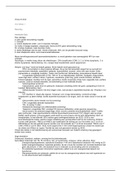College aantekeningen
Summary of all lectures (with illustrations for more clarity!)
This is a summary of all the lectures (1-12) of the course Sport Psychology of the psychology bachelor. It is written in English and contains pictures of slides to make it more clear, for example to help understand different theoretical models. This will help you pass your exam!
[Meer zien]













